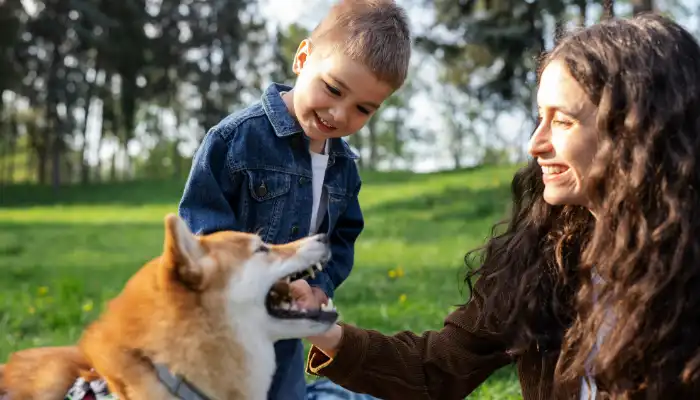With body language, barking, and other sounds, dogs have their own forms of communication and are rather marvelous creatures. Although they lack the ability to speak human languages, canines are capable of conveying their messages. If you have ever asked, “What’s Hello in Dog Language?”, well, so have many people for decades.
Dogs tend to stay mute, however, they are able to execute and react to a variety of human commands and gestures made for greetings. There are several dog translator tools available but it is essential for dog owners to learn how dogs greet each other and their owners, so as to boost the interaction between the dog and its owner. The dog communication is astonishing, and so in a bid to answer, “What’s Hello in Dog Language?”, we will go reveal this world.

How Do Dogs Say Hello?
Dogs don’t translate the word “hello,” however, they use other phrases to express the same. These dogs’ greetings are a blend of body movements, vocal barking, and smelling. Here’s how dogs typically say hello:
1. Body Language
- Tail Wagging: A wagging tail, especially brisk tail wagging, is the most universal way of greeting. Relaxed, sideways wagging usually means the dog is glad to see you.
- Play Bow: When a dog keeps their hind part up while lowering their front legs, it’s actually a way of saying hello and an invitation for play.
- Ears and Eyes: Listeners who hears it idle, broadened and relaxed ears together with squinty eyes demonstrate a soft voice. Ears rested and half opened, stare softened to narrowed eyes speaks of a constitution or calm disposition.
2. Vocalizations
- Barking: A dog’s attention seeking yelps, high pitched and nasaly, can be his or her way of declaring presence. Dogs can use a short, high pitched bark to mean, “I am here. Stop and pay some attention to me.”
- Whining or Whimpering: Some dogs grow subdued when pleased and yelp appealingly if the mood takes them or if they spot a cherished companion.
- Howling: Rather dogs that don’t chime do it more often as expression of warmth some of them tend to howl instead more as means to greet other dogs or humans, particularly if they are hearing people talking.
3. Scent Marking
- Dogs are known to sniff one another as a greeting. Everyone knows that dogs have strong sense of sniff and each one learns from the puppy stage to try this as a means of greeting one another.
So these are some of the common signs that dogs say “Hi” If you observe any of these, your dog might be trying to greet you.
How Do Dogs Greet Humans?
When it comes to meeting new people, dogs tend to modify new behaviors that make sense to them and try to adapt behaviors they possess to our norms. Here’s the way they may wish to greet one of us:
- Jumping Up: Not all scenarios where lifting up is of benefit but for them lifting puts their attention on the mouth area hence they can expect what we do on other canines.
- Licking: It indicates great warmth and obedience. They are undoubtedly cheerful in noting the presence of their owners.
- When the Dog Carries His Toys: For some dogs, the greeting entails the presentation of a toy, which could either be an indication of wanting to play or sharing their favorite thing with you.
Dogs green their owners and other under by showing the above-discussed signs.
How to Greet a Dog?
Greeting a dog requires an understanding of their boundaries, so here are tips to get you started:
Do’s:
- Take Your Time Moving Toward the Dog: When approaching the dog, make sure to go without looking directly at the dog because it might feel threatened.
- Extend Your Hand: Before you pet the dog, allow him to sniff your hand first.
- Speak Gently: If a dog is feeling anxious, just by talking to him calmly, they will feel relaxed.
Don’ts:
- No Hugging: As much as humans love hugging, dogs have a different understanding of it. Humans tend to use it as a way to show love, but for a dog, this might be a bit too restrictive.
- Avoid Making Quick Moves: The jerky motions are ideal for making a dog stitch and move away. Quick movements are not welcome.
- Do Not Initiate Too Much Contact: Whenever dogs seem nervous or uninterested, it is best not to interact with them too much.
Differences Between Dog and Human Greetings
To better understand “What’s Hello in Dog Language?”, let’s compare how dogs and humans greet each other:
| Aspect | Human Greeting | Dog Greeting |
|---|---|---|
| Physical Contact | Handshake or hug | Sniffing, licking, or nuzzling |
| Vocalization | Saying “Hello” or “Hi” | Barking, whining, or howling |
| Body Language | Smiling, waving | Tail wagging, play bow |
So when your furry friend greets you, you need to keep these do’s and don’ts in mind.
Benefits and Importance of Knowing Dog Greetings
The phrase “What’s Hello in Dog Language?” goes beyond mere information – it is very important in terms of relating with your dog. Take a look at some of the points below to understand better:
- Strengthens Bond: When you say hello to your dog in a manner they understand, they will be able to trust and like you more.
- Reduces Stress: A proper approach to a dog will help prevent most misunderstandings and reduce tension in both animals and owners.
- Improves Training: Knowing how your dog talks to you can make training your animal a lot easier and fun.
So these are some of the benefits of knowing dogs’ ways of greeting. With this, you can improve your relationship with your dog and understand it better.
Conclusion
So, “What’s Hello in Dog Language?” A dog’s greeting consists of vigorous tail wagging, crouched bowing, sniffing, and excited barking. If you are able to learn how to mimic these actions, you will be able to say hello to your dog in a way that is natural for them. Ensuring that you have a great relationship with your dog and appreciate every moment spent together can lead to some extremely heartwarming moments for you, regardless of if you are an experienced dog caretaker or simply someone who adores dogs.
